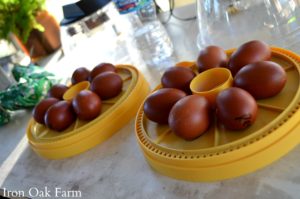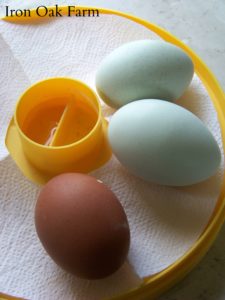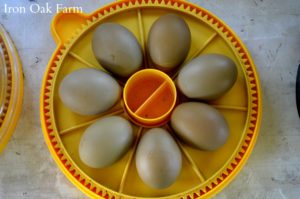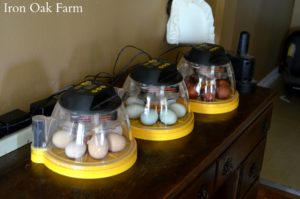 In my opinion, the availability of hatching eggs is the modern miracle of the chicken world. Much like ordering seeds from a seed catalog you can raise chickens from all over the country, even the world via hatching eggs.
In my opinion, the availability of hatching eggs is the modern miracle of the chicken world. Much like ordering seeds from a seed catalog you can raise chickens from all over the country, even the world via hatching eggs.
This virtually makes the availability of breeds endless! It’s exciting to see what it’s doing for the extremely rare breeds and those that are endangered of extinction.
It’s also a great money maker!
But before you start boxing up your eggs to ship, there are a few things you should know.
What are hatching eggs?
 Fresh, fertilized eggs that can be sold to others to put in an incubator and hatch out in a different location.
Fresh, fertilized eggs that can be sold to others to put in an incubator and hatch out in a different location.
What Chicken Breeds Sell Well?
Rare breeds, quality breeds, endangered breeds, breeds that lay interesting colored eggs etc. People might not want to go through the expense or the hassle of buying the more common breeds, (Leghorns, Rhode Island Reds etc.) that they can get from a feed store or their neighbor.
Regulations
Before you start selling hatching eggs, there are a few regulatory matters that need to be researched. Each state has its own rules, but for the most part, at the very least you need to be NPIP Certified. NPIP Certification proves that your flock is Pullorum free. Most states require this certification.
In addition, thse states require an Avian Influenza certification.
North Carolina
Georgia
Florida
Virginia
Texas
Pennsylvania
It is the job of the seller to research the state you are shipping to and find out their regulations.
For more on this check out my NPIP Certification series below here on Homestead Hustle!
What is the NPIP and Pullorum Typhoid Disease?
Who Needs to be Concerned with Pullorum and the NPIP?
Getting Your Flock NPIP Certified
Save Money by Testing Your Flock for Pullorum
Becoming a Certified Salmonella Pullorum Tester
Chicken fertility
 To get fertile eggs, a hen must be with a rooster. I like to get a visual observation of the pair mating, just to make sure the rooster is doing his job. After 2-3 days I check a few test eggs to look for the germinal disk. This appears as a white bullseye on the egg yolk. It is the place where the sperm enters the yolk in the ovaduct.
To get fertile eggs, a hen must be with a rooster. I like to get a visual observation of the pair mating, just to make sure the rooster is doing his job. After 2-3 days I check a few test eggs to look for the germinal disk. This appears as a white bullseye on the egg yolk. It is the place where the sperm enters the yolk in the ovaduct.
After the chicken is fertile, she will continue to lay fertilized eggs for about 10 days. After that fertility wanes off. If she is continuously with the rooster then fertility should stay consistent.
The Logistics
 Once a fertile egg is laid it stays viable for about 10 days. This is your window for packaging, shipping and delivering to your customer. The older the egg, the more the hatch rate goes down. Fertile eggs meant for hatching should ideally be kept at around 65 degrees. They can go down to 40 degrees (some people keep them in their fridge) and ideally not over 80 for extended periods of time.
Once a fertile egg is laid it stays viable for about 10 days. This is your window for packaging, shipping and delivering to your customer. The older the egg, the more the hatch rate goes down. Fertile eggs meant for hatching should ideally be kept at around 65 degrees. They can go down to 40 degrees (some people keep them in their fridge) and ideally not over 80 for extended periods of time.
If the weather is extremely hot or cold, it can affect your hatch rate while the eggs are being shipped.
Hatch Rate
People who are familiar with buying hatching eggs will want to know your hatch rate. This is a percentage of successfully hatched eggs from the number you’ve sold. A good hatch rate is around 80%.
Hatch rate is affected by quite a few things. How old the egg is before it shipped, how it’s handled in the shipping process, the temperature during shipping and the breed. Some of these things are out of your control so be transparent with your customers before making a sale.
Checking your Product
 It’s a good idea to do a few test hatches to see what your hatch rate is. I like to ship a few dozen eggs to friends to let them hatch them out for free to see if the shipment was a success.
It’s a good idea to do a few test hatches to see what your hatch rate is. I like to ship a few dozen eggs to friends to let them hatch them out for free to see if the shipment was a success.
Packaging and Shipping
Packaging supply companies do sell a foam sheet with egg-shaped hole cut out that some people use for shipping eggs. I prefer (and have had better luck with) wrapping each egg several times around with small bubble wrap. Then I wrap the opposite way. I nestle the eggs in a Medium Priority Flat Rate Box from USPS with several layers of additional bubble wrap under, between and over.
Using Flat Rate shipping makes it easy to know what to charge customers for shipping. They usually ship within 1-3 business days. You can also do overnight shipping for an additional cost. Just remember to factor in shipping time with egg viability.
Mark the box FRAGILE and I also write “LIVE HATCHING EGGS” on all sides of the box.
It also makes good business sense to include a few extra eggs in case some break. If I’m selling a dozen eggs, I ship 15.
Disclaimer
When selling eggs it’s good to include a disclaimer with the sale. Be honest about your hatching rate. Decide how you will handle unsuccessful hatches. Will you offer a total refund or leave the risk to the buyer or something in-between. Make this transparent before the sale is made.
Where to find buyers
 The internet! Where else?! One of the best places to start is to post a classified on chicken forums. Facebook is making it challenging to sell hatching eggs with their recent “no animal sales” policy. Some have been saying that this includes hatching eggs. But read the instructions on the forums and they can help you to get the word out.
The internet! Where else?! One of the best places to start is to post a classified on chicken forums. Facebook is making it challenging to sell hatching eggs with their recent “no animal sales” policy. Some have been saying that this includes hatching eggs. But read the instructions on the forums and they can help you to get the word out.
You can also create a website with a sales page.
How much can you make?
Depending on the breed, the quality, the lines, the rarity, and demand… a dozen hatching eggs can be sold anywhere from $20 to $200. Often they are sold in an auction type setting. But you can also offer a set price.
Hatching eggs are a great way to sell some of your chicken stock without the hassle of shipping live birds.










